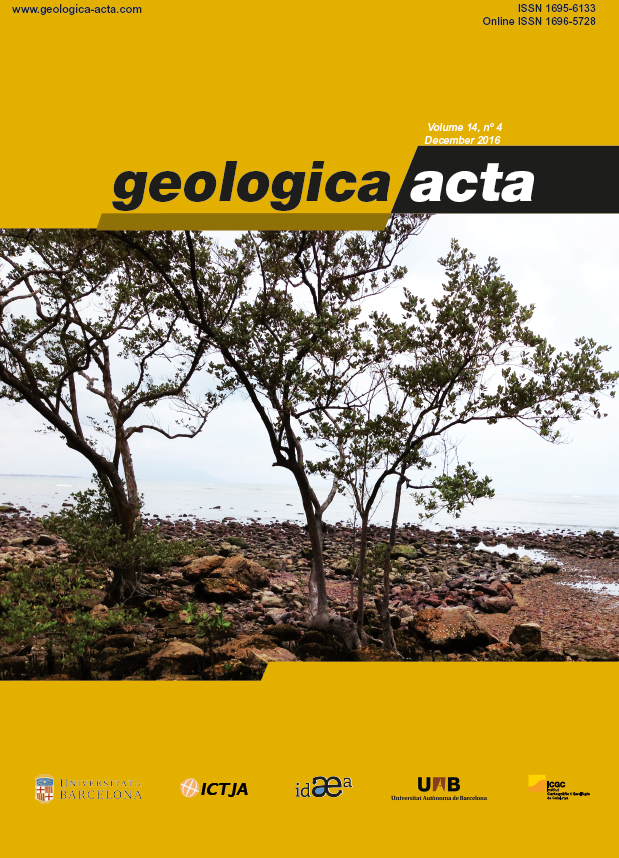Stars in the Silurian sky. A case study from the Carnic Alps, Austria
DOI:
https://doi.org/10.1344/GeologicaActa2016.14.4.1Keywords:
Echinoderms, Holdfast, Functional morphology, Palaeoecology, Iron, Cardiola Formation.Abstract
A small collection of echinoderm holdfasts from the Ludlow Cardiola Formation of the Carnic Alps (Austria) contains a wide range of morphologies as a response of environmental adaptation. In general, the holdfasts have a globous and massive dome-like profile with several processes arranged in a sub-radial disposition, so to create a sort of “star-like” outline. A small central depression is common but not present on all specimens. The distinctive holdfasts are preserved in an iron-rich phase, documenting a substitution that has also affected other non-echinoderm calcareous material.
References
Amemiya, S., Omori, A., Tsurugaya, T., Hibino, T., Yamaguchi, M., Kuraishi, R., Kiyomoto, M., Minokawa, T., 2014. Early stalked stages in ontogeny of the living isocrinid sea lily Metacrinus rotundus. Acta Zoologica, 97, 102-106.
Ausich, W.I., Wilson, M.A., 2016. Llandovery (early Silurian) crinoids from Hiiumaa Island, western Estonia. Journal of Paleontology, 90. DOI: http://dx.doi.org/10.1017/jpa.2016.120
Branson, E.B., Mehl, M.G., 1933. Conodonts from the Maquoketa-Thebes (Upper Ordovician) of Missouri. University of Missouri Studies, 8, 121-132.
Brett, C.E., 1978. Attachment structures in the rhombiferan cystoid Caryocrinites and their paleobiological implications. Journal of Paleontology, 52, 717-726.
Brett, C.E., 1981. Terminology and functional morphology of attachment structures in pelmatozoan echinoderms. Lethaia,
, 343-370.
Brett, C.E., 1984. Autecology of Silurian pelmatozoan echinoderms. Special Papers in Palaeontology, 32, 87-120.
Brett, C.E., Liddell, W.D., Derstler, K.L., 1983. Late Cambrian hard substrate communities from Montana/Wyoming: The oldest known hardground encrusters. Lethaia, 16, 281-289.
Brett, C.E., Ferretti, A., Histon, K., Schönlaub, H.P., 2009. Silurian Sequence Stratigraphy of the Carnic Alps, Austria. Palaeogeography, Palaeoclimatology, Palaeoecology, 279, 1-28.
Brett, C.E., McLaughlin, P.I., Histon, K., Schindler, E., Ferretti, A., 2012. Time-specific aspects of facies: State of the art, examples, and possible causes. Palaeogeography, Palaeoclimatology, Palaeoecology, 367-368, 327-339.
Brower, J.C., 2005. The paleobiology and ontogeny of Cincinnaticrinus varibrachialus Warn and Strimple, 1977 from the Middle Ordovician (Shermanian) Walcott-Rust quarry of New York. Journal of Paleontology, 79, 152-174.
Carpenter, P.H., 1885. On Three New Species of Metacrinus. Transactions of the Linnean Society, 2, 435-446.
Corradini, C., Corriga, M.G., 2010. Silurian and lowermost Devonian conodonts from the Passo Volaia area (Carnic Alps, Italy). Bollettino della Società Paleontologica Italiana, 49, 237-253.
Corradini, C., Suttner, T.J. (eds.), 2015. The Pre-Variscan sequence of the Carnic Alps (Austria and Italy). Abhandlungen der
Geologischen Bundesanstalt, 69, 158pp.
Corradini, C., Olivieri, R., Serpagli, E., 1996. Possible relationship between anomalous conodonts and Silurian oceanic episodes. Neues Jahrbuch für Geologie und Paläontologie Monatshefte, 1996-H.12, 737-746.
Corradini, C., Pondrelli, M., Serventi, P., Simonetto, L., 2003. The Silurian cephalopod limestone in the Monte Cocco area (Carnic Alps, Italy): Conodont biostratigraphy. Revista Española de Micropaleontologia, 35, 285-294.
Corradini, C., Corriga, M.G., Pondrelli, M., Serventi, P., Simonetto, L., 2010. Il Siluriano di Monte Cocco (Alpi Carniche). Gortania Geologia, Paleontologia, Paletnologia, 31, 23-30.
Corradini, C., Corriga, M.G., Männik, P., Schönlaub, H.P., 2015a. Revised conodont stratigraphy of the Cellon section (Silurian, Carnic Alps). Lethaia, 48, 56-71.
Corradini, C., Pondrelli, M., Suttner, T.J., Schönlaub, H.P., 2015b. The Pre-Variscan sequence of the Carnic Alps. Berichte der Geologisches Bundesantsalt, 111, 5-40.
Corradini, C., Suttner, T., Ferretti, A., Pohler, S.M.L., Pondrelli, M., Schönlaub, H.P., Spalletta, C., Venturini, C., 2015c. The Pre-Variscan sequence of the Carnic Alps - an introduction. Abhandlungen der Geologischen Bundesanstalt, 69, 7-15.
Corradini, C., Pondrelli, M., Simonetto, L., Corriga, M.G., Spalletta, C., Suttner, T.J., Kido, E., Mossoni, A., Serventi, P., 2016. Stratigraphy of the La Valute area (Mt. Zermula massif, Carnic Alps, Italy). Bollettino della Società Paleontologica Italiana, 55, 55-78.
Corriga, M.G., Corradini, C., Ferretti, A., 2009. Silurian conodonts from Sardinia: an overview. Rendiconti della Società Paleontologica Italiana, 3, 95-107.
Corriga, M.G., Corradini, C., Walliser, O.H., 2014. Upper Silurian and Lower Devonian conodonts from Tafilalt, southeastern
Morocco. Bulletin of Geosciences, 89, 183-200.
Donovan, S.K., Harper, D.A.T., Håkansson, E., 2007. The root of the problem: palaeoecology of distinctive crinoid attachment
structures from the Silurian (Wenlock) of Gotland. Lethaia, 40, 313-320.
Ferretti, A., 2005. Ooidal ironstones and laminated ferruginous deposits from the Silurian of the Carnic Alps, Austria. Bollettino della Società Paleontologica Italiana, 44, 263-278.
Ferretti, A., Kříž, J., 1995. Cephalopod limestone biofacies in the Silurian of the Prague Basin, Bohemia. Palaios, 10, 240-253.
Ferretti, A., Schönlaub, H.P., 2001. New conodont faunas from the Late Ordovician of the Central Carnic Alps, Austria. Bollettino della Società Paleontologica Italiana, 40, 3-15.
Ferretti, A., Serpagli, E., 2008. Eurytholia plates (Problematica) from the late Silurian of the Austrian Carnic Alps. Revue de Micropaleontologie, 51, 183-187.
Ferretti, A., Histon, K., Schönlaub, H.P., 1999. The Silurian and Early Devonian of the Rauchkofel Boden Section, Southern Carnic Alps, Austria. Berichte der Geologischen Bundesanstalt, 47, 55-62.
Ferretti, A., Serpagli, E., Štorch, P., 2006. Problematic phosphatic plates from the Silurian-Early Devonian of Bohemia, Czech
Republic. Journal of Paleontology, 80, 1026-1031.
Ferretti, A., Histon, K., McLaughlin, P.I., Brett, C.E., 2012a. Time-specific facies: The color and texture of biotic events. Palaeogeography, Palaeoclimatology, Palaeoecology, 367-368, 321-322.
Ferretti, A., Cavalazzi, B., Barbieri, R., Westall, F., Foucher, F., Todesco, R., 2012b. From black-and-white to colour in the Silurian. Palaeogeography, Palaeoclimatology, Palaeoecology, 367-368, 505-519.
Ferretti, A., Cardini, A., Crampton, J., Serpagli, E., Sheets, H.D., Štorch, P., 2013. Rings without a lord? Enigmatic fossils from the lower Palaeozoic of Bohemia and the Carnic Alps. Lethaia, 46, 211-221.
Franzén, C., 1977. Crinoid holdfasts from the Silurian of Gotland. Lethaia, 10, 219-234.
Histon, K., 2012a. Paleoenvironmental and temporal significance of variably colored Paleozoic orthoconic nautiloid cephalopod accumulations. Palaeogeography, Palaeoclimatology, Palaeoecology, 367-368, 193-208.
Histon, K., 2012b. The Silurian nautiloid-bearing strata of the Cellon Section (Carnic Alps, Austria): Color variation related to events. Palaeogeography, Palaeoclimatology, Palaeoecology, 367-368, 231-255.
Hollis, K.A., Ausich, W.I., 2009. Ontogeny and life-history strategy of Barycrinus (Crinoidea, Mississippian). Lethaia, 42, 138-145.
Kammer, T.W., Bartels, C., Ausich, W.I., 2015. Presumed postlarval pentacrinoids from the Lower Devonian Hunsrück Slate, Germany. Lethaia, 49, 307-311.
Kříž, J., 1979. Silurian Cardiolidae (Bivalvia). Sborník Geologických Věd, Paleontologie, 22, 1-157.
Kříž, J., 1998. Recurrent Silurian-lowest Devonian cephalopod limestones of Gondwanan Europe and Perunica. In: Landing,
E., Johnson, M.E. (eds.). Silurian cycles: Linkages of dynamic stratigraphy with atmospheric, oceanic, and tectonic changes. New York State Museum Bulletin, 491, 183-198.
Kříž, J., 1999. Bivalvia dominated communities of Bohemian type from the Silurian and Lower Devonian carbonate facies. In: Boucot, A.J., Lawson, J.D. (eds.). Final report, project Ecostratigraphy. Paleocommunities: A case study from the Silurian and Lower Devonian. Cambridge, Cambridge University Press, 229-252.
Plotnick, R.E., Ebey, C.M., Zinga, A., 2016. A radicle solution: morphology and biomechanics of the Eucalyptocrinites “root” system. Lethaia, 49, 130-144.
Schönlaub, H.P., 1980. Silurian and Devonian conodont localities in the Barrandian. Abhandlungen der Geologischen Bundesaltstalt, 35, 5-57.
Schönlaub, H.P., 1992. Stratigraphy, Biogeography and Paleoclimatology of the Alpine Paleozoic and its implications for Plate Movements. Jahrbuch der Geologischen Bundesanstalt, 135, 381-418.
Schönlaub, H.P., Histon, K., 1999. The Palaeozoic of the Southern Alps. Berichte der Geologischen Bundesanstalt, 47, 6-30.
Schönlaub, H.P., Forke, H.C., 2007. Die post-variszische Schichtfolge der Karnischen Alpen – Erläuterungen zur Geologischen Karte des Jungpaläozoikums der Karnischen Alpen 1:12.500. Abhandlungen der Geologischen Bundesanstalt, 61, 3-157.
Seilacher, A., MacClintock, C., 2005. Crinoid anchoring strategies for soft-bottom dwelling. Palaios, 20, 224-240.
Serpagli, E., Corradini, C., 1998. New taxa of Kockelella (Conodonta) from Late Wenlock-Ludlow (Silurian) of Sardinia. Giornale di Geologia, 60, 79-83.
Serpagli, E., Corradini, C., 1999. Taxonomy and evolution of Kockelella (Conodonta) from Silurian of Sardinia. Bollettino della Società Paleontologica Italiana, 38, 275-298.
Slavík, L., Kříž, J., Carls, P., 2010. Reflection of the midLudfordian Lau Event in conodont faunas of Bohemia. Bulletin of Geosciences, 85, 395-414.
Surmall, C.D., Deline, B., Colmenar, J., Sheffield, S.L., Zamora, S., 2015. New data on Late Ordovician (Katian) echinoderms
from Sardinia, Italy. In: Zamora, S., Rábano, I. (eds.). Progress in Echinoderm Paleobiology. Instituto Geológico y Minero de España, Cuadernos del Museo Geominero, 19, 175-180.
Thomka, J.R., Brett, C.E., 2015. Paleoecology of pelmatozoans attachment structures from a hardground surface in the middle Silurian Massie Formation, southeastern Indiana. Palaeogeography, Palaeoclimatology, Palaeoecology, 420, 1-12.
Venturini, C., 1990. Geologia delle Alpi Carniche centro-orientali. Udine, Pubblicazioni del Museo Friulano di Storia Naturale, 36, 222pp.
von Raumer, J.F., Stampfli, G.M., 2008. The birth of the Rheic Ocean – Early Palaeozoic subsidence patterns and subsequent
tectonic plate scenarios. Tectonophysics, 461, 9-20.
Walliser, O.H., 1957. Conodonten aus dem oberen Gotlandium Deutschlands und der Karnischen Alpen. Notizblatt des Hessischen Landesamtes für Bodenforschung zu Wiesbaden, 85, 28-52.
Zamora, S., Clausen, S., Álvaro, J.J., Smith, A.B., 2010. Pelmatozoan echinoderms colonized carbonat firm ground substrates in high energy environments since the basal Middle Cambrian. Palaios, 25, 764-768.
Downloads
Published
Issue
Section
License

This work is licensed under a Creative Commons Attribution-ShareAlike 4.0 International License.
Copyright
Geologica Acta is the property of the UB, GEO3BCN, IDAEA and UAB. Geologica Acta must be cited for any partial or full reproduction. Papers are distributed under the Attribution-Share Alike Creative Commons License. This license allows anyone to reproduce and disseminate the content of the journal and even make derivative works crediting authorship and provenance and distributing possible derivative works under the same or an equivalent license.
Author Rights
Authors retain the copyright on their papers and are authorized to post them on their own web pages or institutional repositories. The copyright was retained by the journal from the year 2003 until 2009. In all cases, the complete citation and a link to the Digital Object Identifier (DOI) of the article must be included.
The authors can use excerpts or reproduce illustrations of their papers in other works without prior permission from Geologica Acta provided the source of the paper including the complete citation is fully acknowledged.




